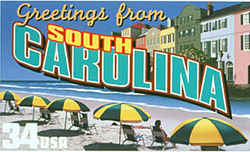


South Carolina Symbols
South Carolina Early History
First Early Inhabitants of South Carolina

Early history examines the archaeological record that tells the story of the first inhabitants of South Carolina. Learn about the prehistory and culture of the first early inhabitants, and what lessons it might teach us about the early history of South Carolina.
South Carolina First Early Inhabitants Timeline
- 48k BCE In 2004 archeologists claimed to have found evidence of human habitation at a site along the Savannah River in Allendale County, SC.
- Paleozoic Era - roughly 540-250 million years ago (most living things were in the oceans)
- Mesozoic Era - roughly 250-65 million years ago (before people)
- Cenozoic Era - 65 million years ago-present - includes the archeological Paleoindian, Archaic, Woodland, Mississippian, and Modern periods Pre-colonial Period - 1500 - 1670
- Paleoindian Period 20,000-8,000 BC Nomadic people, believed to be North America's first inhabitants, crossed from Asia to North America via a land bridge in the Bering Strait formed during the Pleistocene Ice Age. Small bands of people spread out across North America and hunted large game such as mammoths, mastadons, saber-toothed tigers, and bison. By the end of this period, present-day South Carolina was populated by Paleoindians.
- Archaic Period 8,000-1,000 BC - Pleistocene Ice Age ended and the climate warmed. Large game such as mastodons and saber-toothed tigers died out rapidly, possibly due to intensive hunting. Indians began fishing, gathering plants, and hunting smaller game. Groups moved less often and began using a greater variety of tools made of stone, wood, and bone. Pottery was developed in some areas, making food storage easier. Overall population increased due to better adaptation.
- Woodland Period 1,000 BC-900 AD Pottery became widespread. Some groups developed a yearly migration cycle, moving each season to make the best use of their food resources. Semipermanent villages were formed. Plant collection evolved into agriculture. Ceremonial burial of the dead was common. Large earthen mounds were built for ceremonial purposes.
- Mississippian Period 900 AD-1500 AD - The mound building culture flourished and large, permanent towns developed. Corn, beans, and squash became the primary source of food, though hunting and fishing remained important. Crops were planted and harvested communally, providing food for entire villages and large towns. Craftsmen made elaborate tools, jewelry, and ceremonial objects. Extensive trade networks developed.
- 1688 - 1763 - The French and Indian Wars between France and Great Britain for lands in North America consisting of King William's War (1688-1699), Queen Anne's War (1702-1713), King George's War (1744 - 1748) and the French and Indian War aka the Seven Years War (1754-1763)
- 1702-1713 - Queen Anne's War (part of the French and Indian Wars) between the French and Spanish colonies allied with the Wabanaki Confederacy, Mohawk, Choctaw, Timucua, Apalachee and Natchez tribes against the British colonies allied with the Muscogee (Creek), Chickasaw and Yamasee tribes.
- 1715-1717 - Yamasee War a conflict between colonial South Carolina and several Indian tribes, it was also one of the American Indian's most serious challenges to European dominance.
- 1758 - The Anglo-Cherokee War (1758–1761) - The Cherokee uprising in present-day Tennessee, Virginia and the Carolinas
- 1754 - 1763 - The French Indian War is won by Great Britain against the French so ending the series of conflicts known as the
French and Indian Wars
1763 - Treaty of Paris
1776-1794 - Chickamauga Wars aka the Second Cherokee War, a series of conflicts of the Cherokee against the encroachment into their territory. Open warfare broke out in 1776 between the Cherokee led by Dragging Canoe in East Tennessee.
Early History of Native Americans in South Carolina
The Indigenous People of South Carolina
The names of the South Carolina tribes included the Bear River Indians, Cape Fear Indians, Catawba, Cheraw, Cherokee, Chowanoc, Machapunga, Moratok, Natchez, Occaneechi, Saponi, Shakori, Tuscarora and Waccamaw tribes.
In 1520, Spanish explorer Lucas Vásquez Ayllón explored the area near Pawley's Island. The group took about 140 Native Americans as slaves including one man they named Francisco Chicora. Chicora was taken to Spain and taught Spanish. In 1523, he was brought back to the area to assist in establishing a colony, but escaped soon after his arrival. Following exploration of the coast in 1521 by Francisco de Gordillo, the Spanish tried unsuccessfully to establish a colony near present-day Georgetown in 1526. The French also failed to colonize Parris Island near Fort Royal in 1562 with the assistance of the Cusabo Indians.





